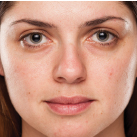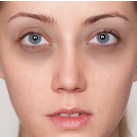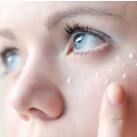By its very nature, the periorbital region that surrounds the eyes is the first area of the face to show signs of aging; this appearance is due to three main factors. At 0.5 millimeter, the skin on the upper and lower eyelids is the thinnest on the body (compared to the two millimeter-average thickness of most facial skin). Its thinness causes it to be slightly transparent, allowing the vascular supply below the skin to be visible on the surface. Secondly, the eye area has fewer oil glands than the rest of the face, making it prone to dryness. This lack of moisture exacerbates the appearance of fine lines and wrinkles. Finally, the skin that surrounds the eyes is constantly moving due to squinting and blinking throughout the day. All of this movement further encourages the formation of fine lines and wrinkles.
While these factors can make the situation sound hopeless, the good news is that nearly all aesthetic eye issues can be fixed. Determining the right approach simply requires an understanding of the various circumstances that lead to these unwanted, aesthetic characteristics of the eye area.
 Puffy Eyes
Puffy Eyes
Many factors cause temporary undereye puffiness and bags. A few examples include fluid retention after lying prone for extended periods, such as during sleep; dehydration, which forces the body to begin storing water; excess alcohol consumption, which reduces antidiuretic hormones in the body; consumption of foods high in sodium, causing fluid retention; hypertension, which forces fluid to seep out of the vessels and into the skin; hormonal changes, such as menstruation or pregnancy; allergies, colds, and sinus infections, all of which lead to inflammation of the sinus tissues; and medical conditions, such as hyperthyroidism, kidney infections, and eye infections, among others. In these instances, suggested treatments include the use of over-the-counter medications and/or the frequent use of nasal irrigation to keep the sinuses clear, improvements in one’s diet, elevation of the head during sleep, improved hydration, and the use of cold compresses on the eye area to slow circulation, thereby reducing swelling and inflammation.
Other scenarios create permanent changes to the structures in the periorbital region, which includes the orbicularis oculi, the muscle that surrounds the eye and is responsible for closure of the eyelids; the orbital septum, a fibrous curtain that connects the eyelids to the orbital bone; and the orbital fat pockets, which are located behind the orbital septum and immediately below the lower eyelids. In many individuals, the orbital septum becomes weak, allowing fat pockets under the eye to herniate forward and press against the orbicularis oculi, creating small bags of puffy adipose tissue under the eyes. While this condition is often associated with middle age and beyond, the truth is, for those with a genetic predisposition to undereye puffiness and bags, this condition can begin much younger.
In situations like these, where undereye bags are considered permanent, one of two treatment options are most often recommended: the use of fillers or surgery. Fillers such as Restylane® and Juvéderm®, can mask the appearance of undereye bags by increasing the volume of the cheeks below. While this nonsurgical procedure is quick and relatively painless, it is not permanent; treatments must be repeated every few months, making it expensive over time.
In some individuals, surgery is the only option. In these cases, blepharoplasty, otherwise referred to as eyelift surgery, is advised. Blepharoplasty can address the aesthetic issues of the entire eye area. On the upper and lower eyelids, the procedure can be used to remove loose, sagging, or excess skin. On the lower eyelids, it can be used to remove undereye bags and fine lines.
To address undereye bags as part of a blepharoplasty, the cosmetic surgeon makes a small incision either under the eyelashes (transcutaneous) or inside the lower eyelid (transconjunctival) to reach the fat pocket below. In the past, surgeons would simply remove the excess fat; this technique is no longer a popular one as removing this fat eventually leads to a hollow appearance in the undereye region as the tissues shrink over time. Most surgeons now simply reposition the fat, tighten the orbicularis oculi muscle, and remove any excess skin. This method is also helpful in preventing dark circles form forming under the eyes.
 Undereye Circles
Undereye Circles
Dark undereye circles are another common concern in the eye area. Like puffiness, this condition also has numerous causes, including poor circulation; allergies; eczema; some medications, such as birth control; excess alcohol or caffeine consumption; lack of sleep; and/or lifestyle choices, including poor diet and smoking. In some individuals with deep-set eyes, the condition is actually an optical illusion caused by the casting of shadows on the undereye region. Most often, however, undereye circles are caused by three main factors: excess melanin pigment in the skin, aging, and/or a genetic predisposition to the condition, especially in those of the African, Asian, Caribbean, Hispanic, Mediterranean, and Middle Eastern descents.
During the aging process, the skin slows its production of collagen (the protein that gives skin its strength), elastin (the protein that gives skin its elasticity), and glycosaminoglycans (substances that surround collagen and elastin and help keep the skin hydrated). This decrease in production causes the skin around the eyes to become increasingly thin, lax, and dry. When this happens, the vascular network present below the skin becomes visible, creating the dark blue hue associated with undereye circles.
To determine the best treatment for undereye circles, it is first necessary to determine the cause. One simple way to do this is to firmly, but gently, press two fingers onto the lower eyelid. If doing so causes the skin directly around it to lighten, the most likely cause of the dark circles is vascular. If the area remains darkened, the likely cause is excess melanin.
Treatments for dark circles that are vascular in nature are intended to either thicken the undereye skin and/or create a cushion between the undereye skin and the underlying orbicularis oculi muscle. Professional treatments include laser resurfacing and chemical peels, which encourage the production of collagen, and the use of fillers or fat grafting to plump the undereye area.
For those whose dark circles are caused by hyperpigmentation, laser resurfacing and chemical peels are also an option, in this case, to destroy pigment cells. An additional treatment is the use of bleaching creams, such as those that contain arnica, hydroquinone, or kojic acid.
 Eye Creams
Eye Creams
There is no shortage of skin care products marketed to address issues concerning the eye area. Unfortunately, it is impossible for a topical treatment to repair structural changes that have occurred in the skin, such as puffiness caused by the redistribution of fat pockets. However, advances in skin care chemistry allow for the improvement of aesthetic issues in the periorbital region that are caused by a reduction in collagen production, dry skin, and/or excess skin pigment.
It is important to note that products marketed specifically for use around the eye area are not always necessary. Rather, active ingredients that are beneficial in the periorbital region are also effective on the rest of the face. A great recommendation, specifically for those patients who suffer from dryness or sensitivity around the eyes, is the use of an eye cream. This recommendation is made because products formulated for the eye region tend to be thicker and contain more oil than traditional facial skin care products. Additionally, a reduced concentration of active ingredients allows them to be gentler on the skin. If the professional chooses to recommend an eye cream to their clientele, the trick is to first find a well-formulated product. Secondly, the challenge is to ensure that the client uses it consistently and for an extended period of time. If the client does not use the product, it is guaranteed that no improvement will be garnered.
Regardless of the type of formulation used on the periorbital region, just enough product should be used to lightly coat the undereye skin. Using too much product is both unnecessary and creates the potential for irritation. When applying the product, clients should gently pat or press the product into the skin and allow it to sit for at least one minute before layering other products or makeup.
Proven ingredients to look for in skin care products for the periorbital region include aloe vera, which reduces inflammation and encourages skin healing; alpha hydroxy acids, which encourage the production of collagen; arnica, an ingredient that aids in pigment reduction; caffeine, which helps to constrict blood vessels; and ceramides, which help to retain moisture. Other great ingredients include hyaluronic acid, which hydrates the skin; kojic acid, an ingredient that aids in pigment reduction; licorice extract, which aids in pigment reduction; niacinamide, a form of vitamin B that aids in pigment reduction; peptides, which encourage the production of collagen and elastin; retinol, a form of vitamin A that encourages cell regeneration and helps to minimize wrinkles; and vitamin C, which encourages the production of collagen.
Prevention
While the causes of common aesthetic conditions of the periorbital region have been explored and various treatment options have been highlighted, the most important message on this topic is that of prevention. With the exception of those who have a genetic predisposition to undereye puffiness and dark circles, or have a medical cause for the formation of these conditions, clients can avoid the formation of puffiness and dark circles by making sun protection a habit. Ultraviolet radiation is the main culprit in skin aging; not only does it break down collagen, it also causes hyperpigmentation, rough texture, dryness, the formation of fine lines, wrinkles, and much more.
"To determine the best treatment for undereye circles, it is first necessary to determine the cause."
For optimal protection, sunscreen should be habitually applied each day, sunglasses should be worn whenever outdoors, and hats and other protective clothing should be utilized when in the sun for an extended period of time. Because most eye creams do not contain SPF, it is necessary to layer with a daytime moisturizer or sunscreen before venturing outdoors.
Finally, it should be noted that there really is something to that old adage about beauty sleep. A recent study1 demonstrated that chronic poor sleep quality can have long-term consequences on the skin, such as higher rates of transepidermal water loss, which leads to dryness; reduced circulation, which causes blood vessels below the skin to appear more prominent; and slower recovery from erythema. Many of these occurrences are factors in the development of undereye puffiness and dark circles. Most importantly, however, the study showed that poor sleepers perceived their physical appearance to be less attractive than that of good sleepers.
At the end of the day, the skin care professional’s role in this industry is to help clients feel like the very best version of themselves. By encouraging them to make their personal health and wellness a priority, professionals not only stand to optimize the client’s appearance, but also to improve their overall happiness.
References
1 Oyetakin-White, P., Suggs, A., Koo, B., et al. (2015). Does poor sleep quality affect skin ageing? Clinical and Experimental Dermatology, 40(1), 17-22.
 Ahmed Abdullah, M.D., F.A.C.S., F.I.C.S. is author of the forthcoming book, Simple Skincare, Beautiful Skin: A Back-to-Basics Approach, CEO and founder of Lexli International, Inc., and formulator of the company’s Lexli® line of professional skin care products. A board-certified plastic/reconstructive surgeon and a leading aloe researcher, Abdullah travels the world, educating licensed professionals and consumers alike about the proper ways to utilize aloe in skin care applications, the essential steps to ensuring the skin’s basic needs are met, and setting the record straight on prevalent skin care myths. He regularly sees patients at his practices in Fargo, N.D. and Dubai, United Arab Emirates.
Ahmed Abdullah, M.D., F.A.C.S., F.I.C.S. is author of the forthcoming book, Simple Skincare, Beautiful Skin: A Back-to-Basics Approach, CEO and founder of Lexli International, Inc., and formulator of the company’s Lexli® line of professional skin care products. A board-certified plastic/reconstructive surgeon and a leading aloe researcher, Abdullah travels the world, educating licensed professionals and consumers alike about the proper ways to utilize aloe in skin care applications, the essential steps to ensuring the skin’s basic needs are met, and setting the record straight on prevalent skin care myths. He regularly sees patients at his practices in Fargo, N.D. and Dubai, United Arab Emirates.
Want to read more?
Subscribe to one of our monthly plans to continue reading this article.